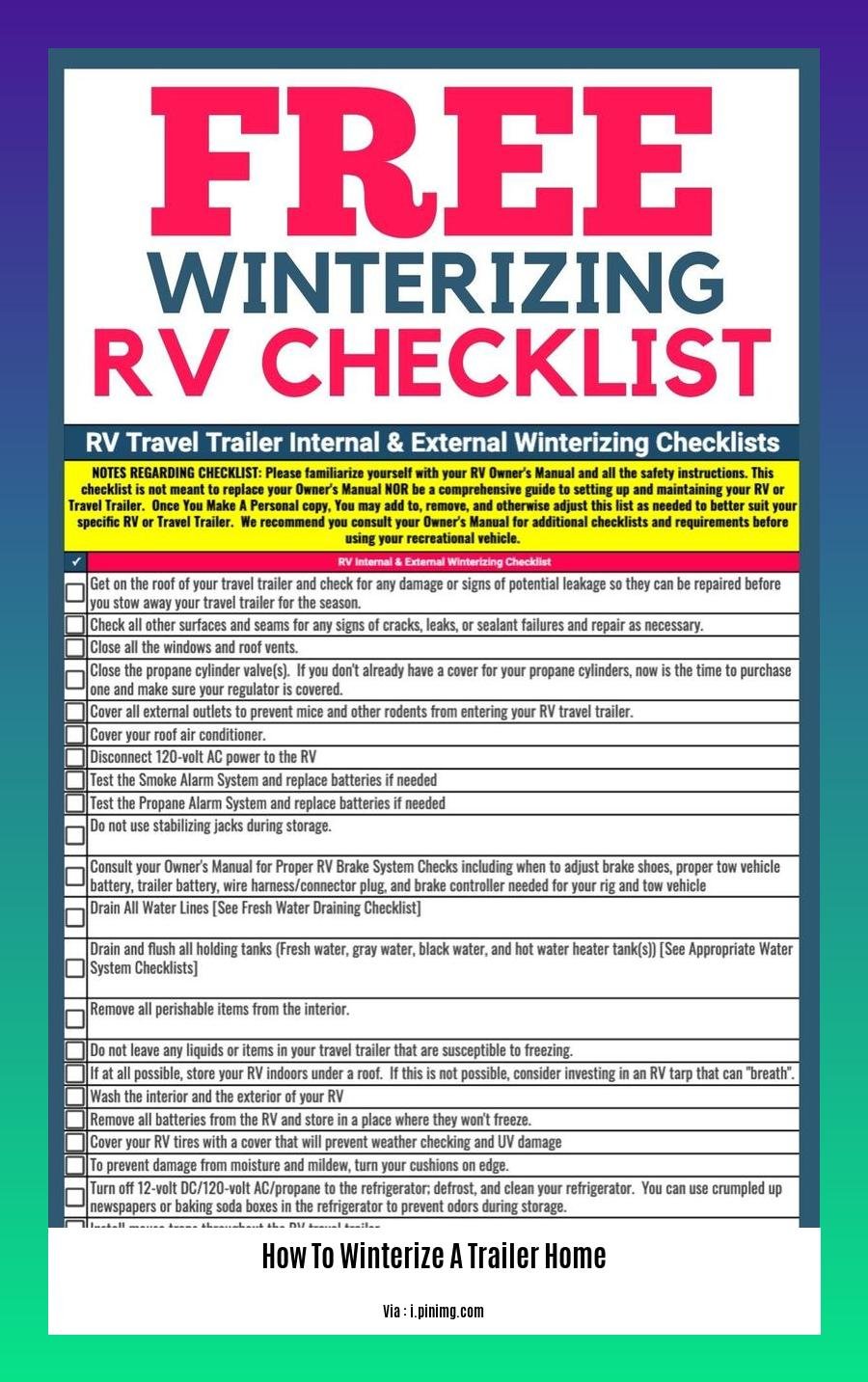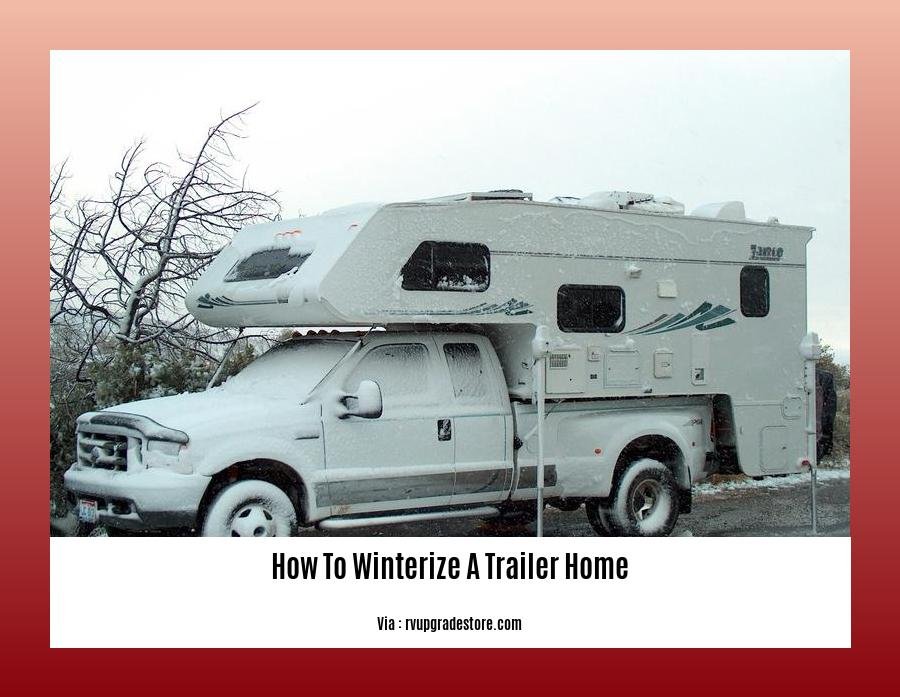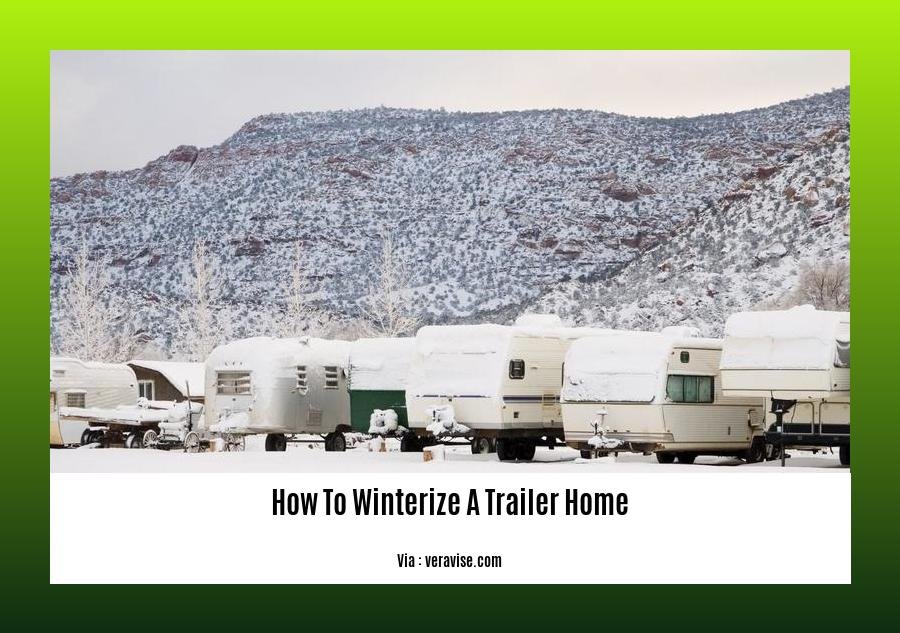Prepare your trailer home for the harsh winter months with our comprehensive guide, [How to Winterize a Trailer Home: A Comprehensive Guide for Homeowners]. Drawing from over a decade of experience enduring cold winters in a trailer home, we’ll share expert tips and techniques to ensure your home’s longevity and comfort during the chilly season.
Key Takeaways:
-
Clean and inspect your trailer’s interior and exterior. Remove food, trash, debris, and check for damages.
-
Disconnect batteries and solar panels to prevent damage during the winter months.
-
Drain and clean waste water tanks then treat them with disinfectant.
-
Drain fresh water tank and water lines, then blow out remaining water with an air compressor.
-
Drain the water heater and treat it with disinfectant.
-
Insulate pipes with foam insulation or heat tape to prevent freezing.
-
Store the trailer in a protected location like a garage or covered storage facility. Block the wheels and disconnect propane tanks.
-
Use non-toxic RV antifreeze in pipes to prevent freezing.
-
Install a water heater bypass kit for easier water heater draining.
-
Seal exterior cracks and damage with silicone sealant.
-
Check and repair roof leaks as needed.
How to Winterize a Trailer Home

As a homeowner with years of experience enduring harsh winters in a trailer home, I’ve encountered challenges and learned valuable lessons in preparing my home for the cold season. I’m sharing my insights and expertise to help you successfully winterize your trailer home, ensuring its longevity and comfort during the cold months.
1. Inspect and Clean Thoroughly:
- Inside and Out: Remove food, trash, and debris. Check for cracks, especially around windows and doors.
- Storage Areas: Empty cabinets, drawers, and closets to prevent damage caused by frozen items.
2. Drain Water Systems:
- Freshwater Tank: Turn off the water supply and open faucets to drain the tank. Use an air compressor to blow out remaining water from lines.
- Water Heater: Shut off the water supply and open the drain valve. Flush it with a hose and treat it with a disinfectant.
3. Disconnect Utilities:
- Batteries: Disconnect batteries to prevent damage from the cold. If leaving them connected, trickle charge them to maintain their health.
- Propane: Disconnect propane tanks and store them in a safe location.
- Electrical: Turn off the main breaker and unplug appliances.
4. Insulate Exposed Pipes:
- Pipes: Use foam insulation or heat tape to protect pipes from freezing.
- Skirting: Install skirting around the trailer’s base to block drafts and cold air.
5. Protect the Roof:
- Inspect the Roof: Check for leaks and repair them promptly.
- Sealants: Apply sealant to any cracks or gaps in the roof to prevent water damage.
6. Secure the Trailer:
- Wheels: Block the wheels to prevent the trailer from rolling.
- Tie-Downs: Secure the trailer to the ground using tie-downs or anchors.
7. Maintain the Interior:
- Moisture Control: Use a dehumidifier to control moisture levels and prevent mold growth.
- Ventilation: Leave a window or vent slightly open to allow air circulation and prevent stale air.
8. Store Wisely:
- Choose a Secure Location: Store your trailer in a garage, covered storage facility, or a sheltered area.
- Prepare for Storage: Clean the interior and exterior thoroughly, and leave the refrigerator and freezer doors open to prevent mold.
Remember, proper winterization not only protects your trailer home from damage but also ensures your comfort and safety during the cold season. By following these comprehensive steps, you can effectively prepare your trailer home for winter and enjoy peace of mind. If you have any further questions or concerns, don’t hesitate to consult with a professional for personalized advice on winterizing your trailer home.
Learn more about how to prepare your mobile home for the colder months here: how to winterize a mobile home.
Is a manufactured home the same as a mobile home? You may find some differences you didn’t expect.
Insulate Exposed Pipes and Tanks
As your trailer home battles winter’s wrath, exposed pipes and tanks endure a relentless onslaught. To prevent a plumbing catastrophe, let’s don our winterizing armor and safeguard these vulnerable components.
Key Takeaways:
- Properly insulating your pipes is essential to preventing freezing and potential bursts.
- Use foam insulation sleeves or heat tape, securing them tightly around pipes.
- Inspect your water heater, ensure it’s drained and properly insulated.
- Seal any gaps or cracks around pipes and tanks to prevent cold air infiltration.
- Skirting around your trailer home provides an additional layer of insulation.
The Insulation Arsenal:
- Foam Insulation Sleeves: These sleeves provide a snug fit around your pipes, acting as a barrier against the cold.
- Heat Tape: With a self-regulating mechanism, heat tape maintains a steady temperature, preventing frozen pipes.
- Sealants: Seal any gaps or cracks around pipes and tanks to keep cold air at bay.
Securing the Water Heater:
- Empty the water heater to prevent freezing and potential damage.
- Insulate the water heater using a water heater blanket or insulation wrap.
Shielding Exposed Pipes:
- Inspect your pipes for cracks, leaks, or damage before insulating.
- Secure insulation sleeves or heat tape tightly around pipes, ensuring no gaps.
- In unheated areas, consider wrapping pipes with multiple layers of insulation.
Skirting for Added Protection:
- Install skirting around your trailer home to create a protective barrier.
- Ensure that the skirting extends below the trailer’s floor joists.
- Opt for insulated skirting material for enhanced protection.
By following these steps, you’ll equip your trailer home to withstand the winter chill, ensuring the comfort and longevity of your pipes and tanks.
Sources:
How to Winterize a Mobile Home Step-by-Step Guide
6+ Practical Ways to Stop Your Mobile Home Pipes from Freezing
Cover and Protect the Trailer Exterior

In the realm of trailer home winterization, shielding the exterior against harsh elements is paramount. Just like a warm coat protects us from the winter’s bite, safeguarding your trailer’s exterior ensures its longevity and comfort. Here’s how to keep your trailer cozy and secure:
1. Inspect and Seal:
Begin by thoroughly examining the exterior for cracks, holes, or any signs of damage. These gaps are like open invitations for moisture to sneak in and cause trouble. Seal them promptly with caulk or weatherstripping. Don’t forget to check the roof for leaks and repair them swiftly.
2. Protect the Roof:
The roof bears the brunt of winter’s fury. Inspect it regularly for any damage or signs of wear. Apply a fresh coat of sealant to any gaps or cracks you find. If you spot any signs of leaks, don’t delay repairs. A sturdy roof is your trailer’s first line of defense against the elements.
3. Cover the Tires:
Winter’s harsh conditions can wreak havoc on your trailer’s tires. Shield them from the elements with durable tire covers. These covers protect against UV rays, cracking, and the drying effects of cold weather.
4. Apply Exterior Protectant:
Treat your trailer’s exterior to a coat of RV wax or protectant. This protective layer shields the surface from the harsh elements, preventing fading and deterioration. It’s like giving your trailer a protective shield against the winter’s wrath.
5. Consider Skirting:
Skirting is like a warm blanket for your trailer. It wraps around the bottom, blocking drafts and preventing cold air from seeping in. Skirting also helps keep rodents and pests at bay.
6. Secure Loose Items:
Loose items like awnings, satellite dishes, and ladders can become dangerous projectiles in high winds. Before winter arrives, secure them tightly to prevent damage to your trailer or neighboring property.
Key Takeaways:
- Inspect the exterior thoroughly for cracks, holes, or damage, and seal them promptly.
- Check the roof for leaks and repair them immediately.
- Cover the tires with durable tire covers to protect them from harsh weather conditions.
- Apply a coat of RV wax or protectant to the exterior to prevent fading and deterioration.
- Consider installing skirting around the bottom of the trailer to block drafts and keep rodents away.
- Secure loose items like awnings, satellite dishes, and ladders to prevent damage from high winds.
Relevant Sources:
Store the Trailer in a Protected Location
Living in a trailer home during harsh winters can be challenging, but with proper preparation and winterization, you can protect your home and ensure a comfortable stay during the cold months. One crucial step in winterizing your trailer home is finding a protected location to store it. Here are some key considerations and tips to help you choose the right storage location:
Key Takeaways:
-
Choose a Level Surface: Select a flat, level surface to park your trailer home. This helps prevent uneven weight distribution and potential damage to the structure.
-
Avoid Low-Lying Areas: Store your trailer home in a location that is not prone to flooding or excessive water accumulation. This minimizes the risk of water damage and keeps your home dry and safe.
-
Provide Adequate Drainage: Ensure that the storage area has proper drainage to prevent water from collecting around your trailer home. Good drainage helps maintain a dry environment and prevents moisture-related issues.
-
Protect from Sunlight: If possible, choose a storage location that offers some protection from direct sunlight. Extended exposure to sunlight can cause the exterior of your trailer home to fade or deteriorate over time.
-
Consider a Covered Storage Space: If available, opt for a covered storage space, such as a barn, garage, or RV storage facility. This provides additional protection from the elements and helps preserve the condition of your trailer home.
-
Secure the Location: Choose a storage location that is secure and has adequate security measures in place, such as fencing, gates, or security cameras. This helps deter theft and vandalism and gives you peace of mind.
By carefully considering these factors and selecting a protected storage location, you can help extend the lifespan of your trailer home and keep it in good condition during the winter months. Remember to inspect the storage area regularly and make any necessary adjustments to ensure the safety and security of your home.
Sources:
FAQ
Q1: What are the essential steps to winterize a trailer home?
A1: The essential steps for winterizing a trailer home include cleaning and inspecting the interior and exterior, disconnecting batteries and solar panels, draining and cleaning waste water tanks, draining fresh water tank and water lines, draining water heater, preventing pipes from freezing, and storing the trailer properly.
Q2: How can I prevent pipes from freezing in my trailer home during the winter?
A2: To prevent pipes from freezing in your trailer home during the winter, you can insulate the pipes with foam insulation or heat tape, use a heated water hose, and install a water heater bypass kit. Additionally, it’s important to seal any cracks or damage to the exterior of the trailer to prevent cold air from entering.
Q3: What are some tips for storing a trailer home properly during the winter?
A3: When storing a trailer home during the winter, it’s important to choose a storage location that is protected from the elements, such as a garage or a covered storage facility. Additionally, you should block the wheels of the trailer to prevent it from rolling, disconnect the propane tanks, and use non-toxic RV antifreeze to prevent the water in your trailer’s pipes from freezing.
Q4: How can I seal any cracks or damage to the exterior of my trailer home to prevent cold air from entering?
A4: To seal any cracks or damage to the exterior of your trailer home to prevent cold air from entering, you can use silicone sealant or caulk. Make sure to check the roof for any leaks and repair them as needed. Additionally, you can install weatherstripping around windows and doors to prevent drafts.
Q5: What are some additional tips for winterizing a trailer home?
A5: Some additional tips for winterizing a trailer home include vacuuming storage bins to prevent crumbs and mice infestation, checking and caulking outside seals to manage humidity, cleaning and storing sewer hoses for the winter, using wheel chocks and stabilizing the RV, and parking the RV out of direct sunlight and considering a protective cover.
- Ceramic Tile Backsplash Ideas for Your Kitchen Remodel - December 21, 2025
- Contemporary Kitchen Backsplash Ideas for a Stylish Home - December 20, 2025
- Modern Kitchen Backsplash Ideas To Inspire Your Refresh - December 19, 2025










